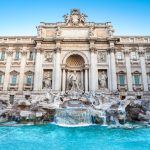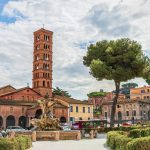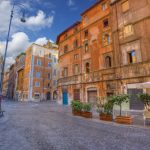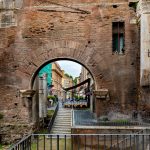Following the footsteps of Audrey…
Rome is known as the eternal city – the city of romance, churches and pizza. But, also, it’s the ultimate in Audrey Hepburn films. Since the William Wyler directed film was released, the Audrey tour has changed considerably in the past 66 years.
Elegant and timeless, the film and the Roman backdrops remain on the must-see list for every new visitor to Rome.
The most notable thing to do in Rome would be to find Gregory Peck. But, since he is no longer around, here are the other highlights of her visit:
Eat gelato
Gelaterias are on every street corner and scattered throughout the city. A tip from the locals is that the best gelato is served from metal tubs, ideally with metal lids. Fruit flavours particularly melon and lemon are fresh and delicious. For something more savoury, pizza is also a must even if you can’t really imagine Audrey eating it.
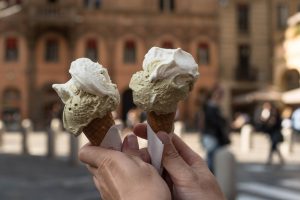
Italian Gelato. Photographed by Olga Klochanko. Image via Shutterstock
Visiting the attractions
Visit the Trevi Fountain, the Spanish Steps, and of course the Bocca della Verita. The Trevi Fountain has been overcrowded for many years; the Olsen Twins visiting in the 90s to make a film probably had quite a bit to do with it at the time. The Romans say that if you throw one coin into the fountain you will return someday to Rome, if you throw two into the fountain you will find true love and if you throw three into the fountain, you can get rid of the person you want that true love to replace. Visiting the Trevi Fountain when it is not crowded is quite a challenge. Very early in the morning is my tip, or in the winter. The Spanish Steps, where Audrey meets Peck, is another must see, but also overcrowded. There is now a fine for sitting on the steps after being asked to move on – ranging from €160 to €400 ($260-$650). There is much more comfortable seating elsewhere. The Bocca della Verita or the Mask of Truth is where Peck brings Audrey to insert her hand. The marble mask is said to claim the hand of anyone telling a lie when their hand is placed into the mouth. Of course, there are queues to take the obligatory Audrey photo here and the charge is by donation only. Santa Maria in Cosmedin, the church in which it stands is beautiful in its own right. On the day we visited, a Korean bride and groom posed for photos inside the church. Best time to go is when there are no tour buses around!
- Trevi Fountain. Photographed by Nicola Forenza. Image via Shutterstock
- Santa Maria. Photographed by Luxerendering. Image via Shutterstock
Walks along the river
Take a walk along the river. The Tiber runs through Rome weaving its way past Isola Tiberina, Castel Sant’Angelo, Piazza del Popolo and the Mausoleum of Augustus. Isola Tiberina is the only island in the river. To reach it you cross Rome’s oldest original bridge, not far from Capitoline Hill. It boasts a 10th-century basilica, fully operational hospital and annual film festival L’Isola Del Cinema from June until September. In the middle of June till the end of the summer on the waterfront from the island to the Pons Cestius there is an evening fair with cocktails, snacks and live music. You can also feel a little of the Audrey spirit with the partying atmosphere along the river and on the riverboats.
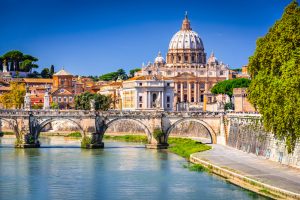
The Tiber. Photographed by cge2010. Image via Shutterstock
The Ghettos
Visit the Jewish Quarter (Quartiere Ebraico) which sits just below Campo de’ Fiori, bordered by the River Tiber and Teatro Marcello. The Ghetto as it was previously known was limited to an area of three streets, walled in and gated. Exits were tightly controlled and there was a curfew for inhabitants. Rules were relaxed around the time of the unification of Italy in 1870 which was also the time in which the Great Synagogue of Rome (Tempio Maggiore di Roma) was built. The Jewish community of Rome goes back to the 2nd century B.C. The area is full of Jewish eateries and Kosher restaurants including Nonna Betta, perhaps the best known. The local delicacy is deep fried artichoke – delicious! On the edge of the Ghetto, is the theatre of Marcus Claudius Marcellus, built by Julius Caesar whom they thought would be a successor to the Emperor. The ruins are a fine example of Roman architecture and another surprise area which is located in the centre of a modern environment.
- Jewish Quarter. Photographed by Phant. Image via Shutterstock
- Jewish Ghetto. Photographed b y Boris B. Image via Shutterstock
See the Vatican
This is a must see at least once in a lifetime. It is truly the centre of the city and the centre of Christendom. Its history is rich and full. In particular, the glory that is the Sistine Chapel should be on everyone’s travel bucket list. There are several ways to see the Vatican, through general admission, skip-the-line tours, or through the latest tour, run by City Wonders, which has an early morning admission time of 6.30am, where tourists can visit the site with the person opening the building with the keys. Do your research before arriving at the Vatican to make sure what you most want to see is open that day.
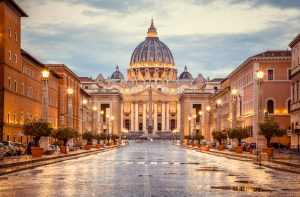
The Vatican. Photographed Vladmir Sazonov. Image via Shutterstock
Do some shopping
Shooping but La Dolce Vita style. The Via Veneto was the centre of Frederico Fellini’s classic film La Dolce Vita, where Anita Ekberg walks before stepping into the Trevi Fountain. Via Veneto is famous for its high-end shopping, with big name designers as well as many other select boutiques. For a little more of the 60s theme, the legendary Harry’s Bar, near the Borghese gardens, has a history of famous faces throughout the years.
Take a trip to the Coliseum
Like the Vatican, you must see the Coliseum once just to understand the Romans and what made them tick. Its architecture is one thing, but listening to the guides talk about the spectacles that occurred in the Coliseum really gives an understanding of what entertained the inhabitants of this advanced (well, in some ways) culture.
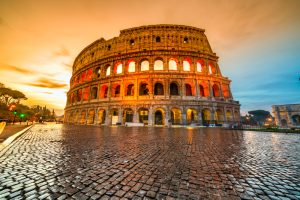
Coliseum. Photographed by Luciano Mortula. Image via Shutterstock
Feature image: Rome. Photographed by S.Borisov. Image via Shutterstock


